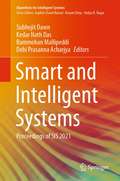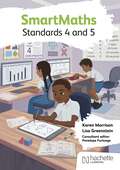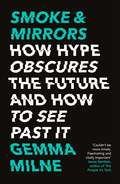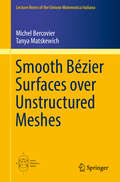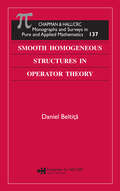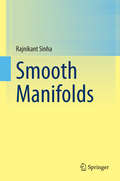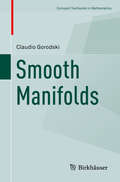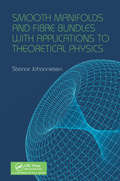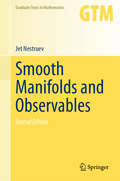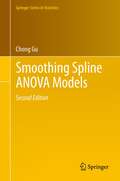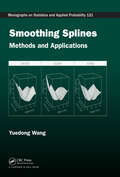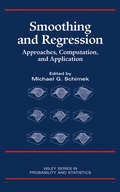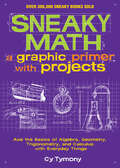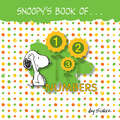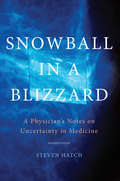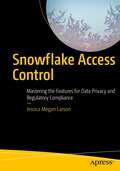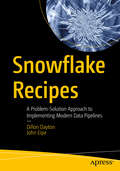- Table View
- List View
Smart and Intelligent Systems: Proceedings of SIS 2021 (Algorithms for Intelligent Systems)
by Kedar Nath Das Subhojit Dawn Debi Prasanna Acharjya Rammohan MallipeddiThis book is a collection of high-quality research papers presented at the International Conference on Smart and Intelligent Systems (SIS 2021), which will be held in Velagapudi Ramakrishna Siddhartha Engineering College (VRSEC), Andhra Pradesh, India, during February 25–26, 2021, in virtual mode. It highlights how recent informatics intelligent systems have successfully been used to develop innovative smart techniques and infrastructure in the field of modern engineering and technology. The book will also be of interest to those working in the field of computational intelligence, smart computer network and security analysis, control and automation system, cloud computing, fog computing and IoT, smart grid communication, smart cities, solar cell synthesis and their performance, green technology, and many more. The contents of this book prove useful to researchers and professionals.
SmartMaths Standards 4 and 5
by Karen MorrisonMaster All Levels of Primary Mathematics Through a Comprehensive Educational Framework. Boost the educational journey of every student with resources that are culturally relevant, accessible and engaging, available in both print and digital formats.· Cultivate mastery of key mathematical concepts through clear, straightforward explanations using step-by-step guidance and real-life examples.· Streamline SEA preparation from the start with a structured course. Beginning with Standard 1 and progressing seamlessly to a focused resource for Standards 4 and 5, prepare students for the SEA with extensive exercises and exam preparation materials that cater to diverse learning styles.· Engage with culturally relevant content authentically reflecting Trinidad and Tobago's local environments, cultures, and realities, developed and reviewed by local contributors and a Consultant Editor.
SmartMaths Standards 4 and 5
by Karen MorrisonMaster All Levels of Primary Mathematics Through a Comprehensive Educational Framework. Boost the educational journey of every student with resources that are culturally relevant, accessible and engaging, available in both print and digital formats.· Cultivate mastery of key mathematical concepts through clear, straightforward explanations using step-by-step guidance and real-life examples.· Streamline SEA preparation from the start with a structured course. Beginning with Standard 1 and progressing seamlessly to a focused resource for Standards 4 and 5, prepare students for the SEA with extensive exercises and exam preparation materials that cater to diverse learning styles.· Engage with culturally relevant content authentically reflecting Trinidad and Tobago's local environments, cultures, and realities, developed and reviewed by local contributors and a Consultant Editor.
Smartphone Safety
by Eric MintonSmartphones offer convenience and fun, but it is important to use them safely. This title points out phone features that owners can use to make their smartphones more secure. It discusses how to safely find, download, and use apps. The connection between smartphones and cyberbullying is addressed. Information about what to do if you lose your phone or need to get rid of an old phone is included, too.
Smoke & Mirrors: How Hype Obscures the Future and How to See Past It
by Gemma Milne'Stop following the news until you've read Gemma Milne's persuasive analysis of the hype and bullshit that distort our understanding of emerging science. As she shows, the starting point to grasping the genuine opportunities of AI, life sciences and climate tech is a healthy dose of critical thinking'David Rowan, founding editor of WIRED UK and author of Non-Bullshit Innovation: Radical Ideas from the World's Smartest Minds'Couldn't be more timely. Fascinating and vitally important'Jamie Bartlett, author of The People Vs Tech'A much-needed blast of fresh air! Gemma Milne expertly shows us how to separate the truth from the hype surrounding the emerging techs of today, and those of the near-tomorrow'Lewis Dartnell, author of Origins: How the Earth Made Us'I loved this book! This is exactly the sort of sceptical, cut-through-the crap-but-still-excited-about-what's-emerging book around tech innovation that's sorely needed, yet is so hard to find . . . essential reading for anyone who's serious about how real-world advances might be effectively harnessed to build a better future'Dr Andrew Maynard, scientist and author of Films from the Future and Future Rising'[A] vital contribution in a world where technological progress promises so much, but too often disappoints. If, like me, you believe that advances in science and technology are our best hope for solving the grand challenges of our times, this book is the indispensable guide to avoiding the mirages and the charlatans along the way'Matt Clifford, co-founder and CEO of Entrepreneur First'A refreshingly grown-up, clear-headed look at the interaction between science, technology and the media - readable without being dumbed down, acknowledging complexities without being heavy'Tom Chivers, author of The AI Does Not Hate You'ROBOTS WILL STEAL YOUR JOB!''AI WILL REVOLUTIONISE FARMING!''GENETIC EDITING WILL CURE CANCER!'Bombastic headlines about science and technology are nothing new. To cut through the constant stream of information and misinformation on social media, or grab the attention of investors, or convince governments to take notice, strident headlines or bold claims seem necessary to give complex, nuanced information some wow factor.But hype has a dark side, too.It can mislead. It can distract. It can blinker us from seeing what is actually going on.From AI, quantum computing and brain implants, to cancer drugs, future foods and fusion energy, science and technology journalist Gemma Milne reveals hype to be responsible for fundamentally misdirecting or even derailing crucial progress.Hype can be combated and discounted, though, if you're able to see exactly where, how and why it is being deployed.This book is your guide to doing just that.
Smoke & Mirrors: How Hype Obscures the Future and How to See Past It
by Gemma Milne'Stop following the news until you've read Gemma Milne's persuasive analysis of the hype and bullshit that distort our understanding of emerging science. As she shows, the starting point to grasping the genuine opportunities of AI, life sciences and climate tech is a healthy dose of critical thinking'David Rowan, founding editor of WIRED UK and author of Non-Bullshit Innovation: Radical Ideas from the World's Smartest Minds'Couldn't be more timely. Fascinating and vitally important'Jamie Bartlett, author of The People Vs Tech'A much-needed blast of fresh air! Gemma Milne expertly shows us how to separate the truth from the hype surrounding the emerging techs of today, and those of the near-tomorrow'Lewis Dartnell, author of Origins: How the Earth Made Us'I loved this book! This is exactly the sort of sceptical, cut-through-the crap-but-still-excited-about-what's-emerging book around tech innovation that's sorely needed, yet is so hard to find . . . essential reading for anyone who's serious about how real-world advances might be effectively harnessed to build a better future'Dr Andrew Maynard, scientist and author of Films from the Future and Future Rising'[A] vital contribution in a world where technological progress promises so much, but too often disappoints. If, like me, you believe that advances in science and technology are our best hope for solving the grand challenges of our times, this book is the indispensable guide to avoiding the mirages and the charlatans along the way'Matt Clifford, co-founder and CEO of Entrepreneur First'A refreshingly grown-up, clear-headed look at the interaction between science, technology and the media - readable without being dumbed down, acknowledging complexities without being heavy'Tom Chivers, author of The AI Does Not Hate You'ROBOTS WILL STEAL YOUR JOB!''AI WILL REVOLUTIONISE FARMING!''GENETIC EDITING WILL CURE CANCER!'Bombastic headlines about science and technology are nothing new. To cut through the constant stream of information and misinformation on social media, or grab the attention of investors, or convince governments to take notice, strident headlines or bold claims seem necessary to give complex, nuanced information some wow factor.But hype has a dark side, too.It can mislead. It can distract. It can blinker us from seeing what is actually going on.From AI, quantum computing and brain implants, to cancer drugs, future foods and fusion energy, science and technology journalist Gemma Milne reveals hype to be responsible for fundamentally misdirecting or even derailing crucial progress.Hype can be combated and discounted, though, if you're able to see exactly where, how and why it is being deployed.This book is your guide to doing just that.
Smoke & Mirrors: How Hype Obscures the Future and How to See Past It
by Gemma Milne'Stop following the news until you've read Gemma Milne's persuasive analysis of the hype and bullshit that distort our understanding of emerging science. As she shows, the starting point to grasping the genuine opportunities of AI, life sciences and climate tech is a healthy dose of critical thinking'David Rowan, founding editor of WIRED UK and author of Non-Bullshit Innovation: Radical Ideas from the World's Smartest Minds'Couldn't be more timely. Fascinating and vitally important'Jamie Bartlett, author of The People Vs Tech'A much-needed blast of fresh air! Gemma Milne expertly shows us how to separate the truth from the hype surrounding the emerging techs of today, and those of the near-tomorrow'Lewis Dartnell, author of Origins: How the Earth Made Us'I loved this book! This is exactly the sort of sceptical, cut-through-the crap-but-still-excited-about-what's-emerging book around tech innovation that's sorely needed, yet is so hard to find . . . essential reading for anyone who's serious about how real-world advances might be effectively harnessed to build a better future'Dr Andrew Maynard, scientist and author of Films from the Future and Future Rising'[A] vital contribution in a world where technological progress promises so much, but too often disappoints. If, like me, you believe that advances in science and technology are our best hope for solving the grand challenges of our times, this book is the indispensable guide to avoiding the mirages and the charlatans along the way'Matt Clifford, co-founder and CEO of Entrepreneur First'A refreshingly grown-up, clear-headed look at the interaction between science, technology and the media - readable without being dumbed down, acknowledging complexities without being heavy'Tom Chivers, author of The AI Does Not Hate You'ROBOTS WILL STEAL YOUR JOB!''AI WILL REVOLUTIONISE FARMING!''GENETIC EDITING WILL CURE CANCER!'Bombastic headlines about science and technology are nothing new. To cut through the constant stream of information and misinformation on social media, or grab the attention of investors, or convince governments to take notice, strident headlines or bold claims seem necessary to give complex, nuanced information some wow factor.But hype has a dark side, too.It can mislead. It can distract. It can blinker us from seeing what is actually going on.From AI, quantum computing and brain implants, to cancer drugs, future foods and fusion energy, science and technology journalist Gemma Milne reveals hype to be responsible for fundamentally misdirecting or even derailing crucial progress.Hype can be combated and discounted, though, if you're able to see exactly where, how and why it is being deployed.This book is your guide to doing just that.
Smooth Bézier Surfaces over Unstructured Quadrilateral Meshes (Lecture Notes of the Unione Matematica Italiana #22)
by Michel Bercovier Tanya MatskewichUsing an elegant mixture of geometry, graph theory and linear analysis, this monograph completely solves a problem lying at the interface of Isogeometric Analysis (IgA) and Finite Element Methods (FEM). The recent explosion of IgA, strongly tying Computer Aided Geometry Design to Analysis, does not easily apply to the rich variety of complex shapes that engineers have to design and analyse. Therefore new developments have studied the extension of IgA to unstructured unions of meshes, similar to those one can find in FEM. The following problem arises: given an unstructured planar quadrilateral mesh, construct a C1-surface, by piecewise Bézier or B-Spline patches defined over this mesh. This problem is solved for C1-surfaces defined over plane bilinear Bézier patches, the corresponding results for B-Splines then being simple consequences. The method can be extended to higher-order quadrilaterals and even to three dimensions, and the most recent developments in this direction are also mentioned here.
Smooth Homogeneous Structures in Operator Theory (Monographs and Surveys in Pure and Applied Mathematics)
by Daniel BeltitaGeometric ideas and techniques play an important role in operator theory and the theory of operator algebras. Smooth Homogeneous Structures in Operator Theory builds the background needed to understand this circle of ideas and reports on recent developments in this fruitful field of research. Requiring only a moderate familiarity with funct
Smooth Manifolds
by Rajnikant SinhaThis book offers an introduction to the theory of smooth manifolds, helping students to familiarize themselves with the tools they will need for mathematical research on smooth manifolds and differential geometry. The book primarily focuses on topics concerning differential manifolds, tangent spaces, multivariable differential calculus, topological properties of smooth manifolds, embedded submanifolds, Sard's theorem and Whitney embedding theorem. It is clearly structured, amply illustrated and includes solved examples for all concepts discussed. Several difficult theorems have been broken into many lemmas and notes (equivalent to sub-lemmas) to enhance the readability of the book. Further, once a concept has been introduced, it reoccurs throughout the book to ensure comprehension. Rank theorem, a vital aspect of smooth manifolds theory, occurs in many manifestations, including rank theorem for Euclidean space and global rank theorem. Though primarily intended for graduate students of mathematics, the book will also prove useful for researchers. The prerequisites for this text have intentionally been kept to a minimum so that undergraduate students can also benefit from it. It is a cherished conviction that "mathematical proofs are the core of all mathematical joy," a standpoint this book vividly reflects.
Smooth Manifolds (Compact Textbooks in Mathematics)
by Claudio GorodskiThis concise and practical textbook presents the essence of the theory on smooth manifolds. A key concept in mathematics, smooth manifolds are ubiquitous: They appear as Riemannian manifolds in differential geometry; as space-times in general relativity; as phase spaces and energy levels in mechanics; as domains of definition of ODEs in dynamical systems; as Lie groups in algebra and geometry; and in many other areas. The book first presents the language of smooth manifolds, culminating with the Frobenius theorem, before discussing the language of tensors (which includes a presentation of the exterior derivative of differential forms). It then covers Lie groups and Lie algebras, briefly addressing homogeneous manifolds. Integration on manifolds, explanations of Stokes’ theorem and de Rham cohomology, and rudiments of differential topology complete this work. It also includes exercises throughout the text to help readers grasp the theory, as well as more advanced problems for challenge-oriented minds at the end of each chapter. Conceived for a one-semester course on Differentiable Manifolds and Lie Groups, which is offered by many graduate programs worldwide, it is a valuable resource for students and lecturers alike.
Smooth Manifolds and Fibre Bundles with Applications to Theoretical Physics: An Introduction To Principles And Practice
by Steinar JohannesenThis book provides a systematic presentation of the mathematical foundation of modern physics with applications particularly within classical mechanics and the theory of relativity. Written to be self-contained, this book provides complete and rigorous proofs of all the results presented within. Among the themes illustrated in the book are differentiable manifolds, differential forms, fiber bundles and differential geometry with non-trivial applications especially within the general theory of relativity. The emphasis is upon a systematic and logical construction of the mathematical foundations. It can be used as a textbook for a pure mathematics course in differential geometry, assuming the reader has a good understanding of basic analysis, linear algebra and point set topology. The book will also appeal to students of theoretical physics interested in the mathematical foundation of the theories.
Smooth Manifolds and Observables (Graduate Texts in Mathematics #220)
by Jet NestruevThis book gives an introduction to fiber spaces and differential operators on smooth manifolds. Over the last 20 years, the authors developed an algebraic approach to the subject and they explain in this book why differential calculus on manifolds can be considered as an aspect of commutative algebra. This new approach is based on the fundamental notion of observable which is used by physicists and will further the understanding of the mathematics underlying quantum field theory.
Smoothing Spline ANOVA Models
by Chong GuNonparametric function estimation with stochastic data, otherwise known as smoothing, has been studied by several generations of statisticians. Assisted by the ample computing power in today's servers, desktops, and laptops, smoothing methods have been finding their ways into everyday data analysis by practitioners. While scores of methods have proved successful for univariate smoothing, ones practical in multivariate settings number far less. Smoothing spline ANOVA models are a versatile family of smoothing methods derived through roughness penalties, that are suitable for both univariate and multivariate problems. In this book, the author presents a treatise on penalty smoothing under a unified framework. Methods are developed for (i) regression with Gaussian and non-Gaussian responses as well as with censored lifetime data; (ii) density and conditional density estimation under a variety of sampling schemes; and (iii) hazard rate estimation with censored life time data and covariates. The unifying themes are the general penalized likelihood method and the construction of multivariate models with built-in ANOVA decompositions. Extensive discussions are devoted to model construction, smoothing parameter selection, computation, and asymptotic convergence. Most of the computational and data analytical tools discussed in the book are implemented in R, an open-source platform for statistical computing and graphics. Suites of functions are embodied in the R package gss, and are illustrated throughout the book using simulated and real data examples. This monograph will be useful as a reference work for researchers in theoretical and applied statistics as well as for those in other related disciplines. It can also be used as a text for graduate level courses on the subject. Most of the materials are accessible to a second year graduate student with a good training in calculus and linear algebra and working knowledge in basic statistical inferences such as linear models and maximum likelihood estimates.
Smoothing Splines: Methods and Applications (Chapman & Hall/CRC Monographs on Statistics and Applied Probability)
by Yuedong WangA general class of powerful and flexible modeling techniques, spline smoothing has attracted a great deal of research attention in recent years and has been widely used in many application areas, from medicine to economics. Smoothing Splines: Methods and Applications covers basic smoothing spline models, including polynomial, periodic, spherical, t
Smoothing and Regression
by Michael G. SchimekA comprehensive introduction to a wide variety of univariate and multivariate smoothing techniques for regressionSmoothing and Regression: Approaches, Computation, and Application bridges the many gaps that exist among competing univariate and multivariate smoothing techniques. It introduces, describes, and in some cases compares a large number of the latest and most advanced techniques for regression modeling. Unlike many other volumes on this topic, which are highly technical and specialized, this book discusses all methods in light of both computational efficiency and their applicability for real data analysis.Using examples of applications from the biosciences, environmental sciences, engineering, and economics, as well as medical research and marketing, this volume addresses the theory, computation, and application of each approach. A number of the techniques discussed, such as smoothing under shape restrictions or of dependent data, are presented for the first time in book form. Special features of this book include:* Comprehensive coverage of smoothing and regression with software hints and applications from a wide variety of disciplines* A unified, easy-to-follow format* Contributions from more than 25 leading researchers from around the world* More than 150 illustrations also covering new graphical techniques important for exploratory data analysis and visualization of high-dimensional problems* Extensive end-of-chapter referencesFor professionals and aspiring professionals in statistics, applied mathematics, computer science, and econometrics, as well as for researchers in the applied and social sciences, Smoothing and Regression is a unique and important new resource destined to become one the most frequently consulted references in the field.
Sneaky Math: A Graphic Primer with Projects (Sneaky Books #9)
by Cy Tymony&“By capitalizing on these real-world applications, Tymony helps conquer much of the fear and dread associated with traditional math lessons.&” (Booklist) Cy Tymony, author of the best-selling Sneaky Uses series, brings his unique, fun hands-on learning approach to all things math. Many people fear math and numbers, even Barbie, who famously said &“Math class is tough&” in her controversial 1992 talking doll version. But in Sneaky Math, Cy Tymony takes tough and turns it into triumph. He shows us how math is all around us through intriguing and easy projects, including twenty pass-along tools to complement math education programs. The book is divided into seven sections: 1. Fundamentals of Numbers and Arithmetic 2. Algebra Primer 3. Geometry Primer 4. Trigonometry Primer 5. Calculus Primer 6. Sneaky Math Challenges, Tricks, and Formulas 7. Resources
Sneaky Math: A Graphic Primer with Projects (Sneaky Books)
by Cy Tymony&“By capitalizing on these real-world applications, Tymony helps conquer much of the fear and dread associated with traditional math lessons.&” (Booklist) Cy Tymony, author of the best-selling Sneaky Uses series, brings his unique, fun hands-on learning approach to all things math. Many people fear math and numbers, even Barbie, who famously said &“Math class is tough&” in her controversial 1992 talking doll version. But in Sneaky Math, Cy Tymony takes tough and turns it into triumph. He shows us how math is all around us through intriguing and easy projects, including twenty pass-along tools to complement math education programs. The book is divided into seven sections: 1. Fundamentals of Numbers and Arithmetic 2. Algebra Primer 3. Geometry Primer 4. Trigonometry Primer 5. Calculus Primer 6. Sneaky Math Challenges, Tricks, and Formulas 7. Resources
Snoopy's Book of Numbers
by Charles M. SchulzTeach your little ones about counting and numbers with the help of Snoopy and his pals.Snoopy's Book of Numbers is the perfect introduction for little ones to learn their numbers along with Snoopy and his Peanuts friends.
SnowPro™ Core Certification Companion: Hands-on Preparation and Practice (Certification Study Companion Series)
by Maja FerleThis study companion helps you prepare for the SnowPro Core Certification exam. The author guides your studies so you will not have to tackle the exam by yourself. To help you track your progress, chapters in this book correspond to the exam domains as described on Snowflake’s website. Upon studying the material in this book, you will have solid knowledge that should give you the best shot possible at taking and passing the exam and earning the certification you deserve. Each chapter provides explanations, instructions, guidance, tips, and other information with the level of detail that you need to prepare for the exam. You will not waste your time with unneeded detail and advanced content which is out of scope of the exam. Focus is kept on reviewing the materials and helping you become familiar with the content of the exam that is recommended by Snowflake.This Book Helps YouReview the domains that Snowflake specifically recommends you study in preparation for Exam COF-C02Identify gaps in your knowledge that you can study and fill in to increase your chances of passing Exam COF-C02Level up your knowledge even if not taking the exam, so you know the same material as someone who has taken the examLearn how to set up a Snowflake account and configure access according to recommended security best practicesBe capable of loading structured and unstructured data into Snowflake as well as unloading data from SnowflakeUnderstand how to apply Snowflake data protection features such as cloning, time travel, and fail safeReview Snowflake’s data sharing capabilities, including data marketplace and data exchangeWho This Book Is ForThose who are planning to take the SnowPro Core Certification COF-C02 exam, and anyone who wishes to gain core expertise in implementing and migrating to the Snowflake Data Cloud
Snowball in a Blizzard: A Physician's Notes on Uncertainty in Medicine
by Steven HatchThere's a running joke among radiologists: finding a tumor in a mammogram is akin to finding a snowball in a blizzard. A bit of medical gallows humor, this simile illustrates the difficulties of finding signals (the snowball) against a background of noise (the blizzard). Doctors are faced with similar difficulties every day when sifting through piles of data from blood tests to X-rays to endless lists of patient symptoms. Diagnoses are often just educated guesses, and prognoses less certain still. There is a significant amount of uncertainty in the daily practice of medicine, resulting in confusion and potentially deadly complications. Dr. Steven Hatch argues that instead of ignoring this uncertainty, we should embrace it. By digging deeply into a number of rancorous controversies, from breast cancer screening to blood pressure management, Hatch shows us how medicine can fail--sometimes spectacularly--when patients and doctors alike place too much faith in modern medical technology. The key to good health might lie in the ability to recognize the hype created by so many medical reports, sense when to push a physician for more testing, or resist a physician's enthusiasm when unnecessary tests or treatments are being offered. Both humbling and empowering, Snowball in a Blizzard lays bare the inescapable murkiness that permeates the theory and practice of modern medicine. Essential reading for physicians and patients alike, this book shows how, by recognizing rather than denying that uncertainty, we can all make better health decisions.
Snowflake Access Control: Mastering the Features for Data Privacy and Regulatory Compliance
by Jessica Megan LarsonUnderstand the different access control paradigms available in the Snowflake Data Cloud and learn how to implement access control in support of data privacy and compliance with regulations such as GDPR, APPI, CCPA, and SOX. The information in this book will help you and your organization adhere to privacy requirements that are important to consumers and becoming codified in the law. You will learn to protect your valuable data from those who should not see it while making it accessible to the analysts whom you trust to mine the data and create business value for your organization.Snowflake is increasingly the choice for companies looking to move to a data warehousing solution, and security is an increasing concern due to recent high-profile attacks. This book shows how to use Snowflake's wide range of features that support access control, making it easier to protect data access from the data origination point all the way to the presentation and visualization layer. Reading this book helps you embrace the benefits of securing data and provide valuable support for data analysis while also protecting the rights and privacy of the consumers and customers with whom you do business.What You Will LearnIdentify data that is sensitive and should be restrictedImplement access control in the Snowflake Data CloudChoose the right access control paradigm for your organizationComply with CCPA, GDPR, SOX, APPI, and similar privacy regulationsTake advantage of recognized best practices for role-based access controlPrevent upstream and downstream services from subverting your access controlBenefit from access control features unique to the Snowflake Data CloudWho This Book Is ForData engineers, database administrators, and engineering managers who want to improve their access control model; those whose access control model is not meeting privacy and regulatory requirements; those new to Snowflake who want to benefit from access control features that are unique to the platform; technology leaders in organizations that have just gone public and are now required to conform to SOX reporting requirements
Snowflake Recipes: A Problem-Solution Approach to Implementing Modern Data Pipelines
by Dillon Dayton John EipeExplore Snowflake’s core concepts and unique features that differentiates it from industry competitors, such as, Azure Synapse and Google BigQuery. This book provides recipes for architecting and developing modern data pipelines on the Snowflake data platform by employing progressive techniques, agile practices, and repeatable strategies. You’ll walk through step-by-step instructions on ready-to-use recipes covering a wide range of the latest development topics. Then build scalable development pipelines and solve specific scenarios common to all modern data platforms, such as, data masking, object tagging, data monetization, and security best practices. Throughout the book you’ll work with code samples for Amazon Web Services, Microsoft Azure, and Google Cloud Platform. There’s also a chapter devoted to solving machine learning problems with Snowflake. Authors Dillon Dayton and John Eipe are both Snowflake SnowPro Core certified, specializing in data and digital services, and understand the challenges of finding the right solution to complex problems. The recipes in this book are based on real world use cases and examples designed to help you provide quality, performant, and secured data to solve business initiatives. What You’ll Learn Handle structured and un- structured data in Snowflake. Apply best practices and different options for data transformation. Understand data application development. Implement data sharing, data governance and security. Who This book Is For Data engineers, scientists and analysts moving into Snowflake, looking to build data apps. This book expects basic knowledge in Cloud (AWS or Azure or GCP), SQL and Python
Snowman - Cold = Puddle: Spring Equations
by Laura Purdie SalasPoetry + Math + Science = A new way of looking at springMath meets metaphor in this eye-opening exploration of spring. Each clever equation is a tiny, perfect poem that prompts readers to look at the ordinary and see the miraculous. Can you look at an egg in a nest and see a jewelry box? How are sunlight and heat like an alarm clock? Engaging sidebars reveal the science behind the signs of spring.
So Many Bunnies
by Rick WaltonFrom the Publisher: Follow Mother Rabbit through her rambling house and garden as she tucks in a whole alphabet of baby bunnies, from Abel through Zed. This cozy bedtime book has the comforting familiarity of a lullaby combined with the fundamental concepts toddlers adore. From Children's Literature - Mary Quattlebaum: So Many Bunnies does double-duty. It gets kids hip-hopping into Easter as well as into National Poetry Month, celebrated each April. Rick Dalton's ingenious rhyming text weaves alphabet and counting lessons into a sweet tale of Old Mother Rabbit who lived in a shoe. Unlike her human counterpart, Mother Rabbit knows just what to do and where to tuck her twenty-six sleepy darlings, from "1 was named Abel./He slept on the table" to "26 was named Zed./He slept on the shed." Paige Miglio's soft-toned watercolors are a lovely complement to this lullaby.
